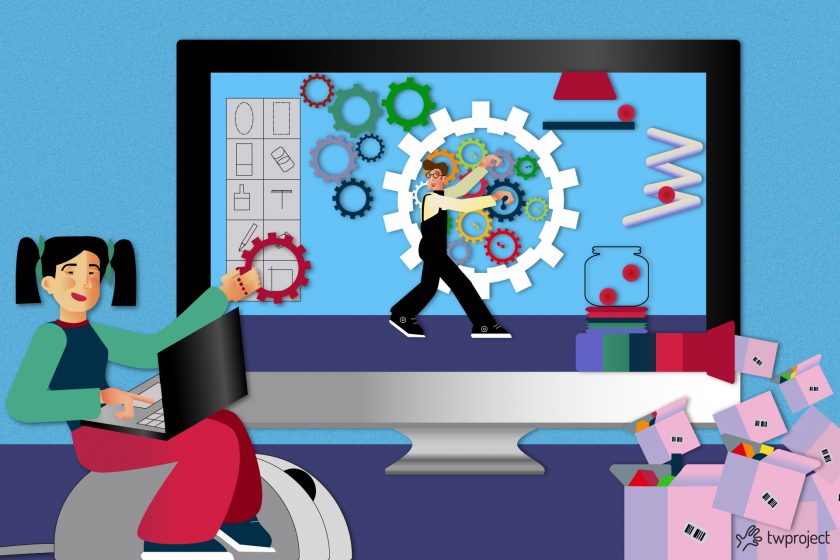From planning to implementation, project management is arguably the most multifaceted challenge for any project manager.
Among planning, coordinating resources, and monitoring progress, the project manager often must navigate a sea of intricacies, trying to balance a myriad of tasks and responsibilities.
CONTENT
In this article, we will discuss project managers’ most common problems in designing and implementing projects and potential solutions.
From design to project implementation: 5 key stages
Project management, from the design stage to implementation, can be broken down into 5 key phases:
- Initiation: this is the stage where the project is defined.
The problem or opportunity is identified, project objectives are determined, stakeholders are identified, and the cost and time required to complete the project are estimated. This stage often terminates with the creation of a project initiation document.
- Planning: during the planning stage, a detailed project plan is developed.
This includes determining the specific tasks to be carried out, resource allocation, setting timelines, and planning for risks. The result is a project plan to direct the team during project execution.
- Execution: This is the stage where the project work is actually executed. The project team carries out the activities outlined in the project plan, employing the assigned resources. During this stage, the project manager monitors the project’s progress and manages any problems or changes that may arise.
- Monitoring and control: During this phase, the project manager monitors the project’s progress in relation to the project plan. This includes tracking time, cost, and project quality, as well as managing any issues or changes that may arise. If necessary, the project plan can be updated to reflect these changes.
- Closing: This is the last stage of the project, where the project gets formally wrapped up. This involves reviewing the project, documenting results and lessons learned, and communicating the success of the project to stakeholders.

3 common problems in project management
Project managers often come across many problems.
Let’s examine the most common ones:
1. Lack of effective planning
One of project managers’ most common problems is ineffective planning.
A solid project plan is critical to ensure all activities are coordinated and the project is completed on time.
Without a proper plan, projects can easily get derailed.
For example, if delays or unforeseen contingencies are not factored in, they can eventually lead to underestimating the time needed to complete the project, leading to delays and additional costs.
Also, it can be difficult to prioritize and allocate resources effectively without proper planning.
2. Resource coordination
Another common problem is resource coordination.
Lack of effective coordination of resources can cause communication problems and misunderstandings within the team.
With no clear vision of who is doing what, resources can be wasted or misused.
For example, two team members might be working on the same task without knowing this, causing double work and wasted resources.
Likewise, resources could be exhausted without proper planning and monitoring before the project is completed, causing delays and higher costs.
3. Lack of transparency in project management
Lack of transparency is a major issue in project management and can have several implications:
- Incomprehension about project status: with no clear and up-to-date view of project status, team members and stakeholders may fail to fully understand where the project stands or the next steps. This can lead to confusion, delays, and decisions based on incomplete or obsolete information.
- Delays in detecting problems: If the project status is not transparent, problems may remain unnoticed until they become critical. For example, if a project is running behind schedule or over budget, it may not be apparent until it is too late to take effective action.
- Lack of responsibility: lack of transparency can also lead to a lack of responsibility. If it is unclear who is responsible for what, it can be tough to hold people responsible for their tasks and ensure that work is done promptly and effectively.
- Low trust: Lastly, it can undermine trust within and between the team and stakeholders. If people feel that information is being kept from them or that they do not have a full view of what is happening, they may question the project’s management and its chances of success.
From design to project implementation with Twproject
Twproject is project management software that helps prevent these issues and effectively manages all of these stages.
It provides the tools to effectively plan, execute, monitor and close projects.
Among these are:
- Effective planning: Twproject offers project planning tools that help create detailed and realistic project plans. These tools can help prevent problems such as underestimating the amount of time and resources needed, ensuring that the project is thoroughly planned from the get-go.
- Resource management: allows resources to be allocated and monitored effectively. This can help prevent problems such as ineffective resource allocation and utilization. It also provides a clear overview of available resources and how they are being used, facilitating planning and decision-making.
- Transparency: Twproject provides a one-stop shop with a dashboard that gives a clear and up-to-date view of project status. This can help prevent problems such as lack of understanding of project status, delays in detecting issues, and lack of accountability.
- Reporting: reporting features are crucial to collecting and presenting project data effectively. These reports can be used to communicate project status to stakeholders, to make informed decisions, and to constantly improve project management processes.
Benefits of using unique software such as Twproject
Complete Traceability: Twproject provides a comprehensive project view, facilitating monitoring and management.
Efficiency: Automates many manual processes, thus saving time and reducing errors.
Better Collaboration: It makes collaboration easier for team members, improving efficiency and work quality.
Customization: It can be customized to fit the specific needs of your project and organization.
As seen in this article, the bottom line is that project management in the manufacturing industry can be tricky and full of challenges.
Using integrated software such as Twproject, project managers can tackle these challenges more effectively, ensuring that projects are completed successfully, on time, and within budget.
The key, and we will never stress it enough, is to fully understand the software’s functionality and how it can be leveraged for the project’s specific needs.
Because, with Twproject, it is not the company that adapts to the software but the software that supports the company!



